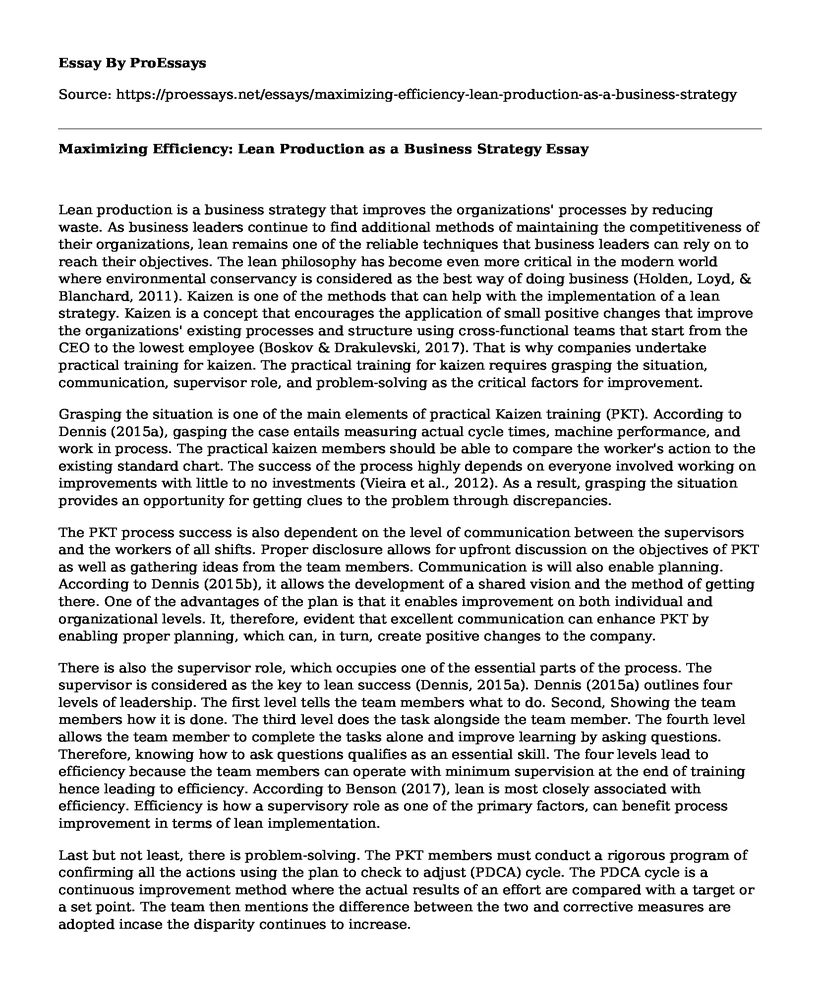Lean production is a business strategy that improves the organizations' processes by reducing waste. As business leaders continue to find additional methods of maintaining the competitiveness of their organizations, lean remains one of the reliable techniques that business leaders can rely on to reach their objectives. The lean philosophy has become even more critical in the modern world where environmental conservancy is considered as the best way of doing business (Holden, Loyd, & Blanchard, 2011). Kaizen is one of the methods that can help with the implementation of a lean strategy. Kaizen is a concept that encourages the application of small positive changes that improve the organizations' existing processes and structure using cross-functional teams that start from the CEO to the lowest employee (Boskov & Drakulevski, 2017). That is why companies undertake practical training for kaizen. The practical training for kaizen requires grasping the situation, communication, supervisor role, and problem-solving as the critical factors for improvement.
Grasping the situation is one of the main elements of practical Kaizen training (PKT). According to Dennis (2015a), gasping the case entails measuring actual cycle times, machine performance, and work in process. The practical kaizen members should be able to compare the worker's action to the existing standard chart. The success of the process highly depends on everyone involved working on improvements with little to no investments (Vieira et al., 2012). As a result, grasping the situation provides an opportunity for getting clues to the problem through discrepancies.
The PKT process success is also dependent on the level of communication between the supervisors and the workers of all shifts. Proper disclosure allows for upfront discussion on the objectives of PKT as well as gathering ideas from the team members. Communication is will also enable planning. According to Dennis (2015b), it allows the development of a shared vision and the method of getting there. One of the advantages of the plan is that it enables improvement on both individual and organizational levels. It, therefore, evident that excellent communication can enhance PKT by enabling proper planning, which can, in turn, create positive changes to the company.
There is also the supervisor role, which occupies one of the essential parts of the process. The supervisor is considered as the key to lean success (Dennis, 2015a). Dennis (2015a) outlines four levels of leadership. The first level tells the team members what to do. Second, Showing the team members how it is done. The third level does the task alongside the team member. The fourth level allows the team member to complete the tasks alone and improve learning by asking questions. Therefore, knowing how to ask questions qualifies as an essential skill. The four levels lead to efficiency because the team members can operate with minimum supervision at the end of training hence leading to efficiency. According to Benson (2017), lean is most closely associated with efficiency. Efficiency is how a supervisory role as one of the primary factors, can benefit process improvement in terms of lean implementation.
Last but not least, there is problem-solving. The PKT members must conduct a rigorous program of confirming all the actions using the plan to check to adjust (PDCA) cycle. The PDCA cycle is a continuous improvement method where the actual results of an effort are compared with a target or a set point. The team then mentions the difference between the two and corrective measures are adopted incase the disparity continues to increase.
References
Benson, B. B. (2017). Lean: Adapting to changing strategies and market conditions. Cost Management, 1, 6-10.
Boskov, T., & Drakulevski, L. (2017). Strategic and Finance Management-Determining Factors for the Success of the Companies in the Business World. Calitatea-access la success (Quality-Access to Success), 18(157), 119-123.
Dennis, P. (2015a). Involvement. Lean production simplified: A plain-language guide to the world's most powerful production system. (pp. 143-159). Routledge.
Dennis, P. (2015). Involvement. Lean production simplified: A plain-language guide to the world's most powerful production system. (pp. 143-159). Routledge
Holden, A., Loyd, N., & Blanchard, L. (2011). A Practical and theoretical approach to sustainability using process improvement. In IIE Annual Conference. Proceedings (p. 1). Institute of Industrial and Systems Engineers (IISE).
Sokovic, M., Pavletic, D., & Pipan, K. K. (2010). Quality improvement methodologies-PDCA cycle, RADAR matrix, DMAIC, and DFSS. Journal of achievements in materials and manufacturing engineering, 43(1), 476-483.
Vieira, L., Balbinotti, G., Varasquin, A., & Gontijo, L. (2012). Ergonomics and kaizen as strategies for competitiveness: a theoretical and practical in the automotive industry. Work, 41(Supplement 1), 1756-1762.
Cite this page
Maximizing Efficiency: Lean Production as a Business Strategy. (2023, May 18). Retrieved from https://proessays.net/essays/maximizing-efficiency-lean-production-as-a-business-strategy
If you are the original author of this essay and no longer wish to have it published on the ProEssays website, please click below to request its removal:
- The Single-Sex High School as a Feature of Secondary Education Has Lost Its Relevance - Argumentative Essay
- Earthquake in Nepal and Its Aftermath Essay
- Management and Leadership Responsibilities Within Early Childhood Educational Paper Example
- Essay Sample on The Green New Deal
- Oil Sands, Keystone XL Pipeline: Environmental Issues & Impact - Essay Sample
- Essay Example on Climate Change: Impact on Human Behaviour and Long-Term Health
- Paper Sample on Hopkins Public Schools: Eisenhower Elementary School







